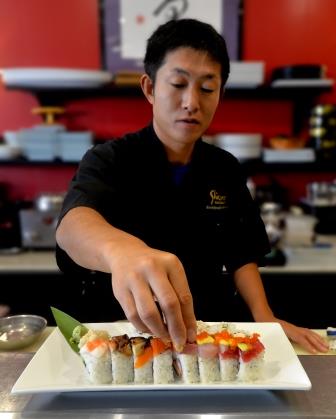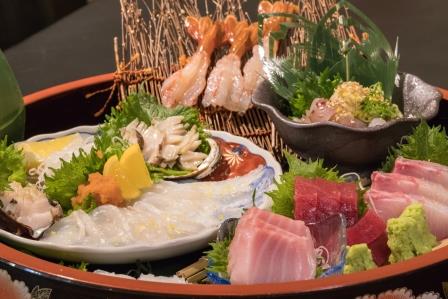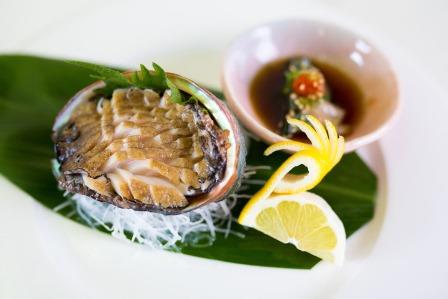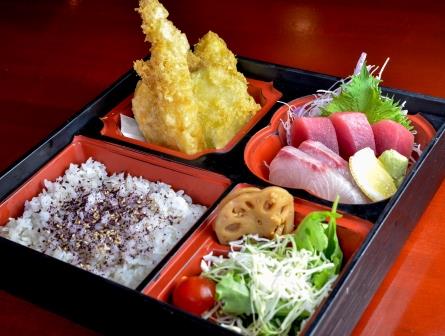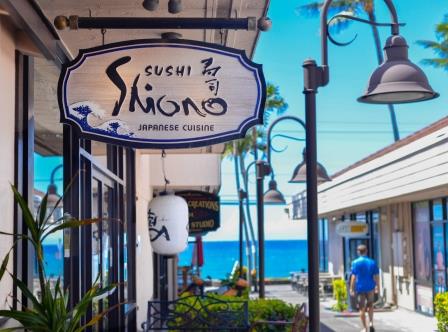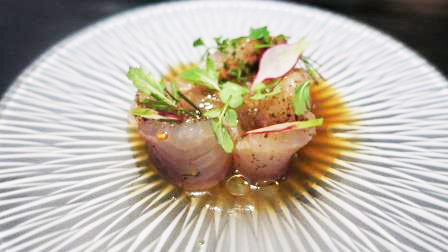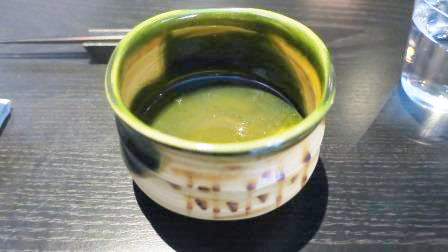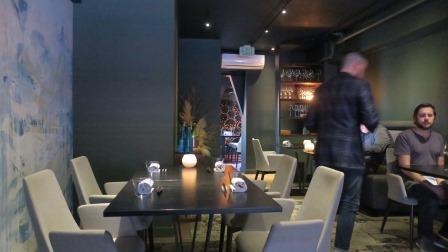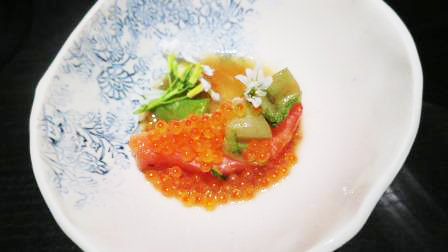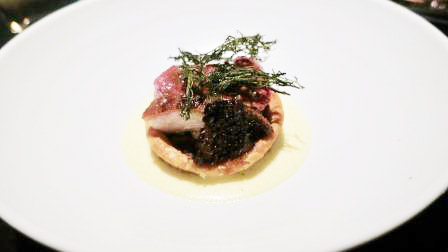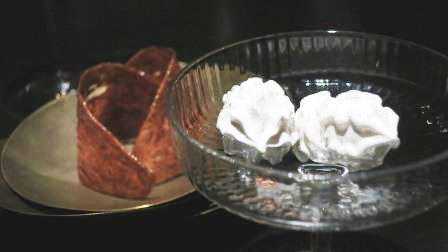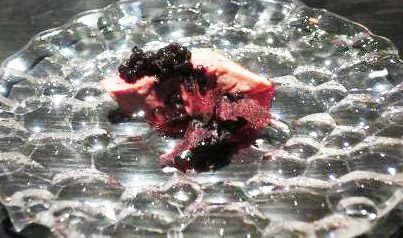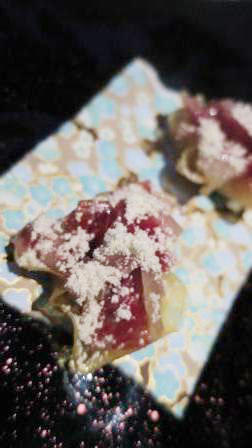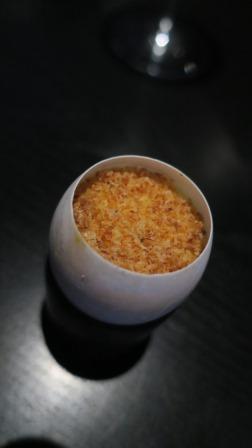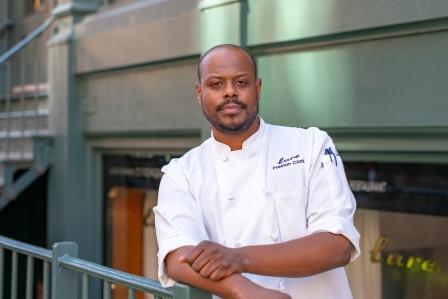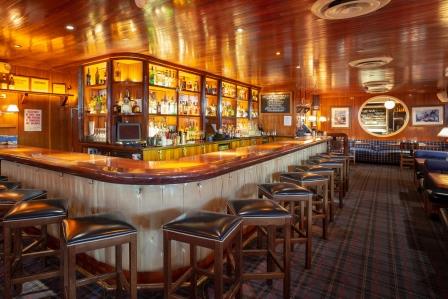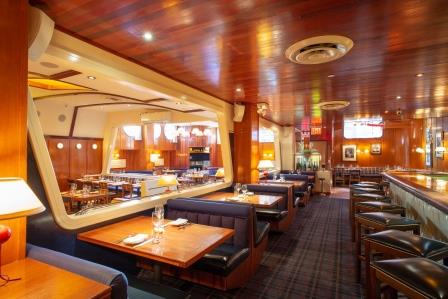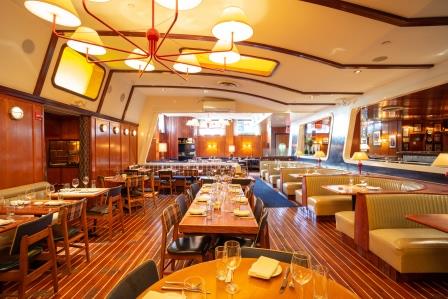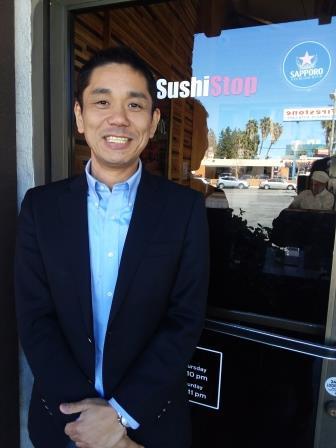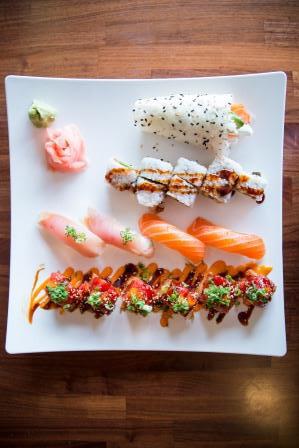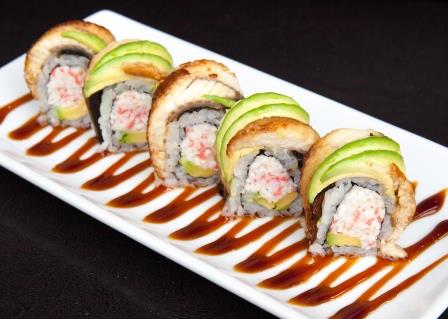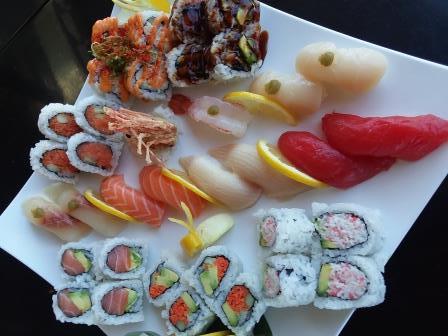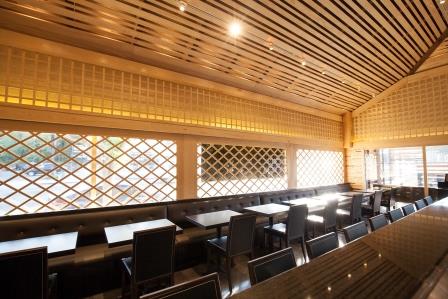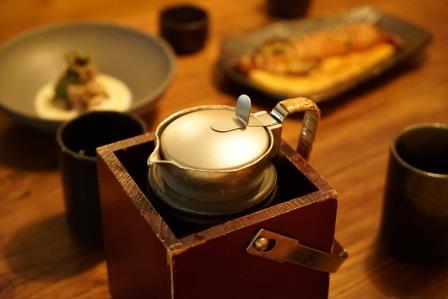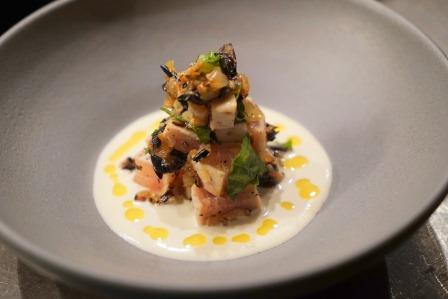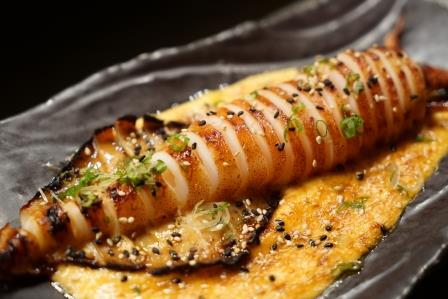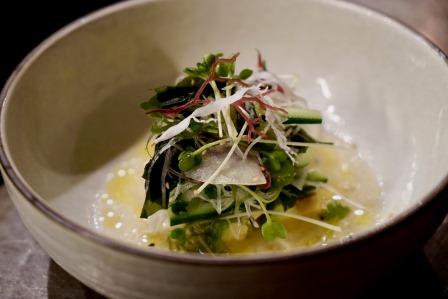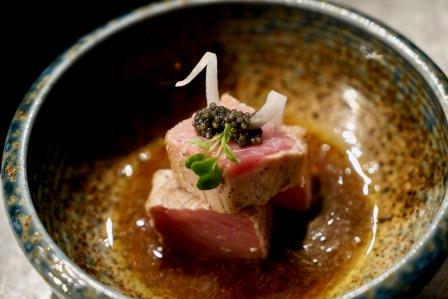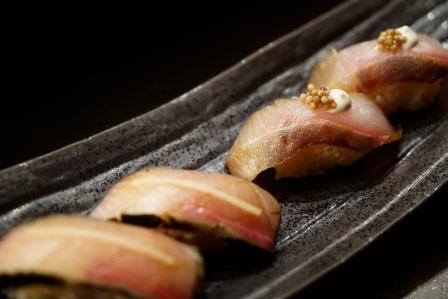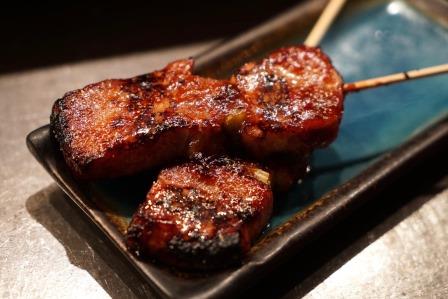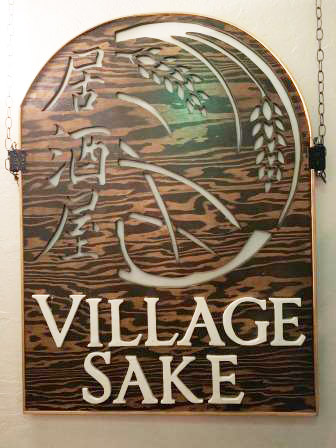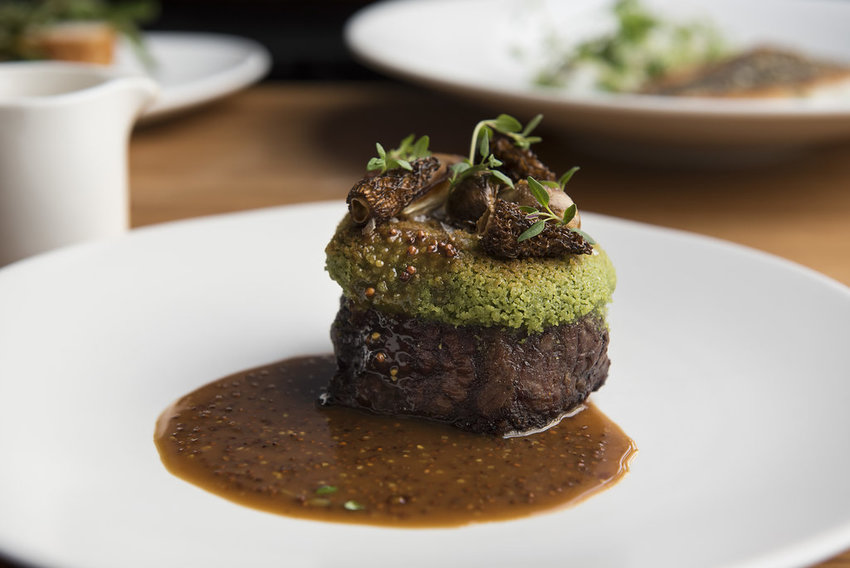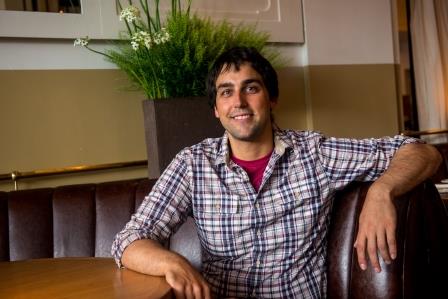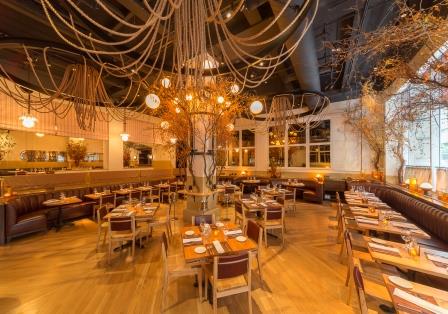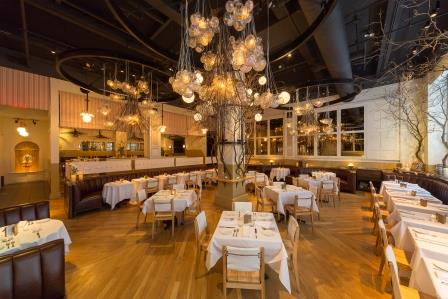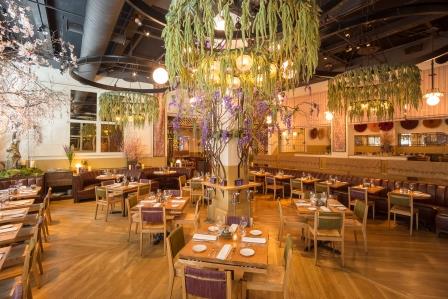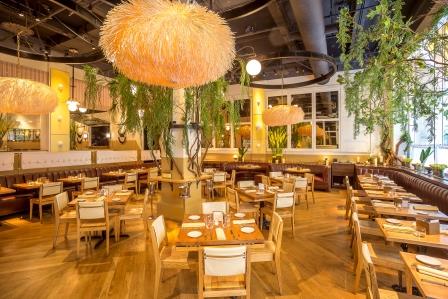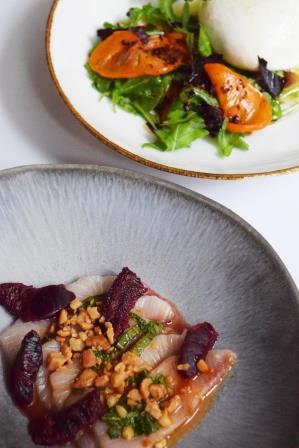
By Keiko Fukuda
Sushi Shiono is a restaurant chain, which has 3 locations on the Island of Hawaii, and each of them is unique. Its Kona location, the first establishment, is a sushi dining place loved by the locals. Its Waikoloa location is a take-out only establishment. It is located in the Queen’s Market Place in the Waikoloa Beach Resort. It has a sushi bar, but is mainly targeted to “Grab and Go” customers. Its third Mauna Lani location, which is about a 5-minute drive north from Waikoloa, is a high-end sushi restaurant, which is very different from the casual Kona location. This place offers omakase, and specially created menu items.
Although these 3 locations are divided by each concept, “a restaurant loved by the locals”, “a take-out only restaurant”, and “a high-end restaurant”, they share the same thing, which is their extreme particularity about the ingredients by using only the fresh seafood caught in the seas near Hawaii, and seafood directly shipped from Japan. Moreover, all of their 4 chefs, who are demonstrating their excellent skills, share experiences of working in Japan.
Now, Sushi Shiono is a popular restaurant chain, which scores high on OpenTable and Yelp; however, I heard that the Kona location was first opened by the owner, who was just a gourmet eater then, as an extension of his hobby.
The owner’s name is Kanichi Shionoya, who runs a generic pharmaceutical company. I heard that Mr. Shionoya, who used to visit the Island of Hawaii to enjoy sport-fishing, thought about opening a sushi restaurant so that he could enjoy the fish he caught there. It became more convincing why he is so particular about the freshness of the ingredients, and bringing chefs from Japan, when I learned that his intention of establishing a restaurant is purely for “his own desire to eat good fish” rather than a business success in mind. This owner also runs various restaurants in Japan besides a sushi restaurant, such as oden, soba, and yakitori restaurants.
I learned from Yuka Murakami of Maruhiro Enterprises, the base operation organization of Sushi Shiono that the Kona location, which is busy with local customers now, used to be filled with Japanese tourists when it first opened in 2003. “Now, our customers consist of 70% locals, 20% tourists, and 10% Japanese who live locally.” Kawakami-san explained the reason for the change of the strategy as follows: “If we aim mainly for tourists as our customers, the number of customers will vary too drastically depending on the season.”
In fact, there are many customers who want to visit the Kona location every week, where sushi chefs rarely change. “Both their dishes and services are the best!”. “You can have genuine Japanese cuisine, not some strange Japanese-like cuisine.” “The taste of sushi made with fresh seafood is superb, and the quality of its vinegared rice is also way better than other restaurants.” “It’s a kid-friendly restaurant, which can be enjoyed by the whole family.” Those are some of the comments the regular customers give.
This is the place famous for serving “genuine Japanese food”. However, they also serve something you can and must taste only in Hawaii. “The Big Island Abalone”, a type of cultivated abalone, is known for its tender texture.
Also, Kona Kampachi is good either as sushi or sashimi. Hawaiian beef is grass-fed in Hawaii, and we serve it as tataki, or sushi.” (by Kawakami)
I had a simple question as to whether Sushi Shiono will ever expand to Oahu or the Mainland. Kawakami-san replied as follows: “I hear that often from the people who visit our Big Island location. I have actually checked out the possibility.
However, due to the fact that our President came to the Big Island to open the restaurant because he loved it here, the chance of us going out of this island in the future is very slim. I would like to keep contributing to the Big Island further into the future by serving the blessings of the island in a delicious way.” However, within the Island of Hawaii, it looks like a piece of new development is on the way. “First, by next summer, we will move the present Kona restaurant to a nearby location. We are planning to make half of the new location a sushi division, and the other half a ramen place. We will keep the lease for the present location, and instead of sushi and ramen, we will reopen it as a different type of Japanese restaurant.” They cannot reveal what type of restaurant it will be yet. I cannot help but keep my eyes on Sushi Shiono, which has settled its roots in the Island of Hawaii to continue to serve Japanese food.
ハワイ島のロコに愛される寿司店
ハワイ島にそれぞれ特色のある3軒の寿司店を出している寿司しおの。1号店であるコナ店は地元客に愛される寿司ダイニング。ワイコロア店はテイクアウトの店。ワイコロア・ビーチリゾートのクイーンズマーケットプレイス内にあり、寿司バーも付設されているが、主に「グラッブ・アンド・ゴー」の顧客がメインのターゲットだ。さらに、ワイコロアから北に車で5分ほど移動した場所にある3店舗目のマウナラニ店は、コナ店のカジュアルな雰囲気とは一線を画す高級志向の寿司店。お任せや創作料理もメニューに並ぶ。
これら3店は、「地元客に愛される店」、「テイクアウト」、「高級志向」とコンセプトを分けてはいるが、共通するのはハワイ近海で獲れた新鮮な魚と日本から直送された魚を扱い、とことん素材にこだわっているという点だ。また、日本での経験を持つ4人の寿司シェフが腕を振るう。
今や繁盛店として、オープンテーブルやYelpでも高得点を獲得している寿司しおのだが、もともとは食通のオーナーが趣味の延長線でコナ店を開けたそうだ。そのオーナーは日本でジェネリック薬品の会社を経営する塩野谷貫一(ルビ:しおのやかんいち)さん。ハワイ島を訪れてはスポーツフィッシングに興じていた塩野谷さんは、現地で釣った魚を美味しく食べたいという気持ちから、島に寿司店を開店することを思い立ったそうだ。ビジネスありきではなく、「自分が食べたい」という純粋な気持ちから店を構えたと聞けば、食材や日本から呼び寄せたシェフに対するこだわりも納得だ。同オーナーは、日本国内でも寿司店、他におでん割烹、蕎麦店、焼き鳥店も経営している。
今は地元客で賑わうコナ店だが、2003年の開店当初、その客層の多くを日本人の観光客が占めていたと教えてくれたのは、寿司しおのの経営母体、マルヒロエンタープライズの川上由香さん。「今は70%がローカルのお客様、20%が観光客、そして10%が現地在住の日本人のお客様といった構成になっています」。地元客向けに戦略を変えた理由を、川上さんは「観光客をターゲットの中心に据えた場合、季節によって来客数のアップダウンが激しくなります」と説明した。
実際、寿司シェフの顔ぶれがほとんど変わることのないコナ店を毎週のように訪れる常連は多い。「料理、サービス共に最高。風変わりな日本食もどきではなく本物の日本食が食べられる」、また「新鮮な魚を使った寿司の美味しさ。酢飯の質も他店のはるか上をいく」「家族で楽しめるキッズフレンドリーな店」といったコメントが常連からは聞かれる。
「本物の日本食」を出すことで定評のあると同店だが、ぜひ食したいハワイならではのマストなネタもある。「ビッグアイランド・アバロンという養殖アワビは柔らかい食感で有名です。また、コナ・カンパチは寿司でも刺身でもおすすめです。ハワイ牛はハワイ産のグラスフェッドビーフ。これをタタキにしたり、またお寿司でもお出ししています」(川上さん)。
オアフ島やメインランドには寿司しおのは進出しないのかという素朴な疑問が浮かぶ。川上さんの返答は次のようなものだった。「ハワイ島の当店にいらっしゃった方にそのようなお話をいただくことは多いです。実際、下見に行ったこともあります。しかし、社長がハワイ島が好きでここに店を出したということもあり、今後、ハワイ島の外に出る可能性は非常に低いと思います。今後もハワイ島の恵みを美味しく提供することで、さらにハワイ島に貢献していきたいと考えています」。ただし、ハワイ島内では新たな展開が生まれそうだ。「まず、夏頃には、今のコナ店をすぐ近くの場所に移転させます。その店舗の半分を寿司店に、残りの半分をラーメン屋さんにする計画です。今の店のリースはそのまま継続し、寿司やラーメンではなく、別の業態の日本食店を新たにオープンさせます」。それが何の店になるかはまだ秘密だそうだ。ハワイ島に根を張って、日本食を提供し続ける寿司しおのから目が離せそうにない。
Sushi Shiono (Kona)
75-5799 ALii Dr. Kailua-Kona, HI 96740
(808)326-1696
http://www.sushishiono.com
Mon.-Thu.11:30am-2:00pm, 5:30pm-9:00pm
Fri. 11:30am-2:00pm, 5:30pm-10:00pm
Sat. 5:30pm- 10:00pm
Sun. 5;00pm-9:00pm

By Mayumi Schroeder / Photo: Elli Sekine
“Avery” is a new rising star among the high-end restaurants in San Francisco, which opened last year on Fillmore Street, where many select shops and popular restaurants stand. This restaurant was featured in the San Francisco Chronicle, Eater Magazine, etc., and has been talked about a lot. The owner/chef, Rodney Wages (34) has a background in French cuisine, but does not have any experience in working or being trained at Japanese restaurants. He says the place offers an American-style izakaya menu. It sounds like izakaya means “a-la-carte” to him. The interior of the restaurant is sophisticated and black color-based, and there is no sign outside. Opening the front door leads you to an elegant, chic, and high-class atmosphere.
Rodney learned the basics of French cuisine at Le Cordon Bleu, Minneapolis, and in 2004, he encountered Cory Lee, who was the Executive Chef of “French Laundry”, a Michelin 3-starred restaurant at that time. Then, he worked there as an intern, and started to show his talent as a chef. 4 years later, he worked in Korea with Mr. Lee. In 2010, he joined the launch of Mr. Lee’s restaurant, “Benu”, which is presently Michelin 3-starred. After that, he has worked as a sous chef at a few Michelin-starred restaurants such as “Morimoto Napa”, “Saison”, and “Atelier Crenn”. “RTB”, which was a pop-up restaurant launched by Mr. Wages in 2017, was a big success, and gave him the big boost to open “Avery” later.
At “Avery”, a modern and sophisticated course menu showcases not only the knowledge and techniques Rodney has accumulated, but also his cooking philosophy which is built in. “I wanted to create an American course menu in which Asian food ingredients are used, and served not with chopsticks, but a knife and a fork like a western style menu,” says Rodney. In this restaurant, pairing is done only with Japanese sake and champagne. Their sake sommelier is Daniel Bromberg, who has a broad knowledge of Japanese culture and sake, and has worked for “True Sake” and “Les Clos”, and is a powerful contributor for their sake selection.
The dashi used for Avery’s course menu contains kombu and katsuobushi, which gives some depth to the umami of its dishes. The sauce has been completed by combining flavors of French, Japanese, and Korean cuisines harmoniously, and its delicate yet rich taste also gives a depth to the dishes. The food ingredients come from farmer’s markets, and also some well-known contracted farms in the suburbs.
This time, I got to taste 11 dishes of the “Chef’s Omakase Course” ($130). To pair with sake, you pay $89, and with champagne, $189 more, respectively. Among them, the following dishes took my breath away when I saw them delivered to the table; “Dashi mariné of sashimi-style fish and vegetables”, which consists of 3 kinds of fish, shima-aji, horse mackerel, etc., which has been aged for a week, and soaked in salt, and then their aroma enhanced by Bincho-charcoal grilling, and “Oyster Berry”, which is Iberico ham perfectly matched with pureed sunchoke, served in a cup made out of dried sunchoke. As for “Goose egg and Oyster lips”, a neatly emptied eggshell is used as the container of the egg yolk and dashi mixed with butter broth, in which you can enjoy crispness and creaminess at the same time.
“Aebleskiver”, a popular dish from the RTB period, is also included in the course. I couldn’t help but smile about its clever presentation when I saw it. The dish was Dungeness crab meat wrapped in Danish pancake, and it was brought to the table on a palm of a monkey figurine. Another nice dish was “Roasted duck”. A locally grown duck from the Sonoma area was aged for several weeks before roasted, and the rich fatty duck was flavored with cognac and balsamic vinegar. The topping was blueberries, which gave a good balance to the entire taste of this dish.
It was an excellent sophisticated course, and I fully enjoyed the delicate and artistic presentation of each dish.
For pairing, aside from the Saga prefecture’s junmai-ginjo, “Tembuki”, and Junmai-ginjo, “Miyasakae”, there were kinds which were clean and a good match to rich food, such as “Midorikawa”, on the sweet side, Yamaguchi prefecture’s “Dassai 50”, “Yamahai Junmai-ginjoshu, Jijoshu”, etc., which ultimately enhanced the dishes.
“This is just the beginning. I anticipate acquiring a Michelin star in the future,” Rodney told me, as his aspiration. I can feel the coming of more high-end Japanese courses in the future.
ハイエンドのコース料理に最高の酒ペアリング
セレクトショップや人気レストランが数多く立ち並ぶサンフランシスコ市のフィルモアストリートに去年オープンしたハイエンドレストランの新星、「Avery」。サンフランシスコ・クロニクル紙やEater 誌などに掲載された話題のレストランだ。“ アメリカン居酒屋メニュー”というオーナーシェフのロドニー・ウェイジス氏(34)は日本食レストランでの修行経験がないフレンチ出身のシェフ。居酒屋というのは彼の中で「一品」を意味しているようだ。同店は黒を基調とした洗練されたインテリアで、外には看板がなく、中に入るとモダンでスタイリッシュな内装が広がっている。
ル・コルドン・ブルーのミネアポリス校でフレンチの基礎を学び、2004 年にミシュラン3 つ星の「French Laundry」で当時エグゼクティブシェフを務めていたコーリー・リー氏と出会う。その後、インターンシップとして同レストランに勤務しシェフとしての頭角を現していった。4 年後には韓国でリー氏のスーシェフを務めた。2010 年に、現在ミシュラン3つ星を持つリー氏のレストラン「Benu」の立ち上げチームに加わった。
その後も「Morimoto Napa」や「Saison」、「Atelier Crenn」のミシュラン星レストランでスー・シェフを務めている。その彼が2017 年に手掛けたポップアップレストラン「RTB」が大ヒット、これが「Avery」をオープンする大きなキッカケとなった。
「Avery」ではロドニーが今まで培ってきた知識や技術だけでなく、彼の料理哲学を盛り込んだモダンで洗練されたコースメニューを提供している。「箸を使わずに西洋風にナイフやフォークを使って食べる、アジア食材を使ったアメリカンのコース料理を作りたかった」とロドニー。同レストランでのペアリングは日本酒とシャンペンのみ。酒ソムリエは、日本文化や豊富な日本酒の知識を持ち「True Sake」や「Les Clos」での経歴を持つダニエル・ブロムバーグ氏で、酒選びの頼もしい味方だ。
「Avery」のコース料理に使用される出汁には昆布や鰹節が使用されており、料理の旨味に奥深さを与えている。ソースはフレンチや日本食、韓国料理を調和した味わいに仕上げられ、繊細だが濃厚な味付けが料理に深みを加えている。食材はファーマーズマーケットや郊外の某有名農家と取引している。
今回は「シェフお任せコース($130)」から11 品を賞味させて頂いた。(酒ペアリングは$89、シャンペンのペアリングは$189 が追加料金となる)その中でもシマアジやホースマカレルなど3 種類の魚を1 週間熟成させた後に塩で締め、備長炭で香りを出した「刺身風の魚と野菜の出汁マリネ」や、イベリコハムと菊芋のピューレクリームの相性が抜群の「オイスターベリー」が菊芋を乾燥させたカップで運ばれて来た時にはその美しさに目を惹かれた。同様に綺麗にくり抜かれた鴨の卵の殻を器として使用し、黄身と出汁&バターのブロスで和えた「鴨の卵とオイスターリップス」はクリスピーからクリーミーな食感を一度に楽しめる一品。
RTB 時代の人気メニュー「Ableskiver」もコースに組み込まれ、デニッシュ風パンケーキにダンジェネスクラブのクリームが入った料理がサルの置物の手の平に乗って運ばれて来た時はその演出に思わず笑みが浮かんだ。他にもソノマの地元産鴨を3 ~ 4 週間かけて熟成された「ローストダック」は、脂がのった味わい深い鴨をコニャックやバルサミコ酢で味付けし、トッピングのブルーベリーとアレンジする事で味のバランスを整えている。全ての料理の繊細で芸術的なプレゼンテーションに堪能する事が出来た洗練されたコースだった。
またペアリングには「佐賀県の純米吟醸“ 天吹”」や「純米吟醸“Miyasakae”」の他に、クリーンな飲み口でリッチな食事との相性が良い「緑川」、甘口系の「山口県の“獺祭50”」や「山廃純米吟醸酒 時醸酒」などで、料理を最高に引き立た。
「この店はまだ最初の1 歩だが、将来はミシュラン星も想定している」と意気込みを語るロドニー氏。今後の更なるハイエンドなコース料理と酒ペアリングの進化を期待したい。
Avery
1552 Fillmore Street
San Francisco, CA 94115
(415) 817-1187
Website: www.AverySF.com
Social Media: @avery_sf
Wed.-Sun. 5:30pm-9:30pm

By Kosuke Kuji
Nambubijin is the first sake brand in the world to satisfy the Jewish dietary requirement by acquiring “Kosher” certification in 2013.
Thanks to this Kosher certification, the sales route for Japanese sake overseas is gradually changing from the conventional channels known for Japanese restaurants and grocery chains.
Needless to say, it is common knowledge among Japanese sake brewers and anyone remotely familiar with sake for that matter that sake is brewed without using any animal products.
Why not emphasize this “common knowledge” more? I was advised by an American mentor that “the most precious values are common sense values,” thus I recognized receiving third party certification for these “commonly known” values will expand the possibility of widespread consumption for Japanese sake.
Therefore, I went ahead and acquired the first ‘vegan’ certification for Japanese sake in both Japan and worldwide to encourage the consumption of Japanese sake among vegan consumers.
Our certification was acquired from the Japan Vegan Society domestically, and from The Vegan Society overseas.
Currently, ‘delicious’ flavor is also the expected standard in the wine industry, with priority given to “safety, reliability, and natural” products as key terms, along with “Non GMO” wine and “BIO” certified wine selections emerging in the market.
Currently, Japanese sake is consumed overseas paired with Japanese cuisine among foreign nationals who are familiar with and friendly towards Japan. That in itself is wonderful, and I’m grateful for our foreign consumers of Japanese sake.
However, looking ahead 20 and 30 years into the future, acquiring ‘vegan’ certification for Japanese sake, “commonly known” to contain no animal products of any kind, will lead to new opportunities for market development.
Therefore, I’d like to encourage more sake breweries acquiring these certifications in the near future to help establish an impression that “Japanese sake is vegan, therefore safe, reliable, and natural” worldwide.
「世界初!ヴィーガン認定の日本酒」
南部美人では、2013年にユダヤ教の食餌規定である「コーシャ」の認定を取得しました。
このコーシャの認定をきかっけに、海外での日本酒の販売ルートが、従来の日本食レストランや日本食スーパーから少しずつ変化をしてきました。
そんな中で、日本酒は動物性の物質を一切使わずに仕込みをしていることは、私たち蔵元はもちろん、少し日本酒を知っている人ならば誰でもわかる常識です。
その「当たり前」をなぜもっと言わないのか、もっと言うと「その当たり前に尊い価値があるのだ」とアメリカの恩人からアドバイスをされ、その「当たり前」をしっかりと第三者に認定してもらう事で、さらに日本酒の可能性が広がると感じ、この度、完全菜食主義者の方々が食べられる、飲むことが出来る認定「ヴィーガン」を日本、そして海外で世界で初めて認定していただきました。
日本国内は日本ヴィーガン協会、海外はThe Vegan Societyでの認定となります。
今、ワインの世界でも「おいしい」は当たり前で、その先に「安心・安全・自然」がキーワードとなっていて「NON GMO」のワインや、「BIO」認定のワインなどもたくさん出てきています。
日本酒もまだまだ日本食と日本を好きな外国人が飲んでいる状況ですが、それはそれでとてもありがたい事ですが、この先20年、30年先の未来に向けて、日本酒の「当たり前」である動物性の物質を一切使わず仕込んでいる事を「ヴィーガン」の認定として受ける事で、新たな市場開拓に繋がります。
この先、多くの蔵元がヴィーガン認定を取ることで、「日本酒はヴィーガンだから安心・安全・自然」というイメージを世界で定着させていきたいと思います

I’m often asked by Americans, “I often use wine for cooking, but can I also use Japanese sake?” Japanese sake contains many umami flavors not found in wine, so it’s great that they can be used in anything.
Eliminating odors
Of course, sake is not only effective in eliminating odors from fish and seafood, but also from pork and lamb. Of course the odor dictates lamb meat, however, when adding Japanese flavor to your cooking, add Japanese sake to any food when the odor is too strong, then leave it for approximately two minutes for the odor to disappear.
Effective in softening proteins
Placing chicken breasts, red beef, and / or meat for stew in a zip lock bag filled with sake prior to marinating eliminates the dryness from the meat and adds flavor. Sake greatly enhances the flavor of meat for barbeque and yakiniku.
Adds umami flavor
From broiled dishes to soup dishes, Japanese sake is useful in a variety of dishes, as our readers know. Surprisingly, Japanese sake also enhances the flavors of Western soup, especially in seafood, along with pasta and various other dishes. Please give it a try. Actually, sake is also great when used even in instant ramen noodles!
Japanese sake is great for cooking
Sake for cooking or Junmai sake is great for food preparation. While Ginjo and Daiginjo are great for drinking, Junmai is better suited and more effective for cooking due to it’s higher concentration of umami flavors.
日本酒と料理
よくアメリカ人から聞かれるのが、「ワインは料理に使うけど日本酒も使えるのか?」ということだ。日本酒には、ワインにない旨み成分がたくさんあるので何でも使用できるのがうれしい。
臭い消し
もちろん、魚介類にも効果があるが、豚肉やラムなどの匂いを消す効果がある。この匂いがあるからこそラム肉かもしれないが、和風な味つけにするときには、ちょっと匂いが強すぎる時に日本酒をかけ、約2分くらい放置すると臭みも消える。
タンパク質柔軟効果
鶏の胸肉や牛の赤身、シチュー用の肉を下味をする前に日本酒を入れたジップロックバックに入れておくとパサパサ感がとれ美味しくなる。バーベキューや焼肉がもっと美味しくなるのだ。
旨味追加
煮付けからどんな汁物まで日本酒は使えるのは皆さんも周知の事実。意外にも洋食のスープ、特にシーフードの入れるもの日本酒を入れるとさらに美味しくなる。もちろんパスタやその他の料理にも使えるので試していただきたい。
実はインスタントラーメンに少し入れても美味しい。
料理に向く日本酒
料理酒や純米酒がよい。吟醸、大吟醸酒は飲むのには良いが、料理としての効能は旨みが多い純米酒がベターである。
清酒和菜餚
經常從美國人口中聽到:「葡萄酒可用於烹飪;但清酒也可以嗎?」這問題。令人雀躍的是,清酒含有許多葡萄酒沒有的甘甜成分,能使用於各式各樣的菜餚上。
消除臭味
它固然對海鮮有效;但亦具有消除豬肉和羊肉氣味的效果。雖亦言正因有這氣味才能稱為羊肉;但是當製作日式風味菜餚時,覺得氣味太濃的話可以加入清酒,放置約2分鐘能令氣味消失。
蛋白質軟化效果
如果你將雞胸肉,牛肉紅肉和燉肉在調味前放入帶有清酒的拉鍊袋中,就能夠消除肉的乾燥感,從而變得更美味。亦會令到燒烤和烤肉變得更美味。
添加甘味
眾所周知,從燉以至各種汁物,都能夠使用清酒。出乎意料的是,西式湯,特別是包含海鮮的,加入清酒可使之更加美味。當然亦可用清酒來烹飪意大利麵和其他菜餚,請務必一試。
事實上,放上少許清酒於即食麵上也很美味。
與菜餚相配的清酒
推薦烹飪用清酒和純米酒等。吟釀、大吟釀等清酒雖然很好喝;但對於烹飪菜餚,最為有效的莫過於甘味豐厚的純米酒。
�
니혼슈와 요리
미국 사람들로부터 "와인은 요리에 사용하곤 하는데 니혼슈도 사용할 수 있습니까?" 라는 질문을 종종 받습니다. 니혼슈에는 와인에는 없는 감칠맛 성분이 많기 때문에 어디에든 사용할 수 있어서 좋습니다.
냄새 제거
물론 어패류에도 효과적이지만 돼지고기나 양고기 등의 냄새를 없애는 데도 효과가 있습니다. 양고기 특유의 냄새가 매력적일 수도 있지만, 일본식 양념을 할 때 냄새가 너무 강한 경우 니혼슈를 뿌리고 약 2 분 정도 두면 냄새도 사라집니다.
단백질 유연 효과
닭가슴살이나 쇠고기의 살코기, 스튜용 고기를 밑간하기 전에 니혼슈가 담긴 지퍼백에 넣어두면 뻑뻑한 느낌이 없어지면서 맛있어집니다. 바베큐나 구이용 고기가 더 맛있어지는 것입니다.
감칠맛 추가
조림부터 찌개까지 니혼슈를 다양하게 사용할 수 있다는 것은 여러분도 잘 알고 있을 것입니다. 의외로 양식 수프, 특히 해산물이 들어간 음식에 니혼슈를 넣으면 더욱 맛있어집니다. 물론 파스타나 다른 요리에도 사용할 수 있으니 시도해 보면 좋을 것 같습니다.
실은 인스턴트 라면에 약간 넣어도 맛있습니다.
요리와 잘 어울리는 니혼슈
요리주나 준마이슈가 좋습니다. 긴죠나 다이긴죠는 마시기에는 좋지만 요리로서의 효능을 보자면 감칠맛이 좋은 쥰마이슈가 더 좋습니다.

By Aya Ota
In the SOHO District where stylish and unique boutiques and galleries stand, there is a door a few steps down from the street level. Opening the door will lead you to an extraordinary space that looks like the interior of a deluxe cruise ship, and entertains you. This is “Lure Fishbar”, one of New York’s prominent seafood specialty restaurants. There, you find creative and ingenious dishes, in which fresh and high-quality seafood is generously used, and worldwide cooking techniques and seasonings are effectively used. There is a raw bar with a wide variety of oysters and clams, and the main dishes include flavorful clam chowder, bisque, grilled or steamed seafood; each of which is cooked properly depending on the ingredient. Sushi and sashimi are the core items of the menu, and account for 30 to 35% of the entire sales.
It was in 2014 when Preston Clark, the Executive Chef of “Lure Fishbar” was hired. His father is a well-known chef who has received an award from the James Beard Foundation, and he has been brushing up his talent and skills since childhood. He also has an honorable record as a nominee for the Rising Star award by the same Foundation. For him, it was the first time to work for a seafood specialty restaurant, but he has created new tastes utilizing his past experiences in working for various famous places such as “Jean George”, a leading French restaurant in New York, and “El Paso” in San Francisco, etc. “Sea Urchin Bucatini” is one of the items he is most proud of. A rich sauce made with generous portions of blue crab meat coats Bucatini pasta, and Hokkaido sea urchin is generously placed on top. The dish doesn’t seem complicated at first glance, but actually a complex and delicate taste has been created by accentuating it with crust made with 3 kinds of chill peppers and garlic. “Hellfire Roll” ($22) is a dish which is colorful and playful. It is a unique roll-style sushi, on which spicy tuna is rolled inside, and seared tuna pieces are added on top.
Kimchee flavor is used effectively. Ponzu-flavored “Kanpachi Sashimi” ($23) provides a rhythmical texture, and added wasabi stem, shallot, garlic, and ginger enhance the taste of the basic ingredients. Other favored Japanese food ingredients they use include raw wasabi, soy sauce, miso, and yuzu. He told me that he learned how to handle seafood and Japanese ingredients from Jean George, who is a Japanese cuisine connoisseur.
Mr. Clark supervises not only the entire cooking aspect as a chef, but also the business aspect. It is not easy to keep attracting customers to such a large-scale restaurant and be profitable at the same time in a place like New York which is a highly competitive market. This restaurant operates from lunch through dinner without a break, and interestingly, they have set up a special period between 3 and 5pm as “Late Lunch”. Due to the nature of the location like SOHO, they try to accommodate a wide variety of customers from locals to tourists. Not only that, the period is the switching point from lunch to dinner, and works well for both efficient operation and profitability. They use social media to attract customers by not only explaining the dishes, but also introducing the health benefits of seafood, and cultural background of each dish.
They also have an excellent lineup of Japanese sake brands. Mariah Bryand, Manager of the restaurant, has acquired a sake sommelier license, and she has carefully selected 20 Japanese sake brands that are a good match to seafood.
Japanese cocktails such as “Soho Sōtō Martini” ($20) made with Junmai Daiginjo and “Red Eye” ($18) with plum wine are also popular. One Junmai Daiginjo brand is featured and introduced as the “Sommelier Selection Sake” every season, and explained in detail about the charm of the featured brand.
You can fully enjoy the depth and broadness of seafood cooking here at “Lure Fishbar”. You feel like trying different dishes and liquors one after another. This is a place full of inspiration and surprises.
世界各国の料理技術や調味料を駆使した魚介料理や寿司
お洒落で個性的なブティックやギャラリーが立ち並ぶSOHO地区。路面から数段降りた位置にある扉を開けると、豪華客船内をイメージした優雅で非日常的な空間が広がり、高揚した気分になる。ここは、ニューヨーク有数のシーフード専門店『Lure Fishbar』。新鮮で高品質な魚介類をふんだんに使い、世界各国の料理技術や調味料を駆使し、創意工夫に富んだ料理が並ぶ。牡蠣やあさりなど豊富な種類を取りそろえたロー・バー、風味豊かなクラムチャウダーやビスク、グリルやスチームなど素材に合わせた技法で調理されたメイン料理……。寿司や刺身は同店メニューの中心的存在で、売上の30〜35%を占めるという。
プレストン・クラーク氏が、『Lure Fishbar』の料理長に就任したのは2014年のことだ。父親はジェイムス・ビアード財団から表彰された著名な料理人であり、幼少の頃から才能と技術を磨いてきた。彼自身も同財団のライジング・スターにノミネートされたという輝かしい経歴を持つ。魚介専門店は初体験だったが、過去に、ニューヨークを代表するフレンチ『Jean George』やサンフランシスコの『El Paso』など、数々の名店で培った知識や経験を活かして、新しい味を創り出している。「Sea Urchin Bucatini」は、クラーク氏自慢の一品。ブルー・クラブをふんだんに使った濃厚なソースをブカティーニ・パスタに絡め、北海道産ウニを贅沢にトッピング。一見シンプルに見えるが、3種類の唐辛子で作ったクラストやニンニクをアクセントにし、複雑で繊細な味を創り上げている。『Hellfire Roll』(22ドル)は彩り鮮やかで遊び心にあふれた内容。ピリ辛味のマグロを巻き込み、さらに炙ったマグロの切り身を乗せるという独特な巻き寿司で、キムチ味を効かせている。ポン酢風味の『Kanpachi Sashimi』(23ドル)には、ワサビ茎、エシャロット、ニンニク、生姜がリズミカルな食感を加え、素材の味を引き立てる。他の日本食材では、生ワサビ、醤油、味噌、柚などを好んで取り入れている。魚介や日本食材の扱い方については、日本食通のジャン・ジョルジュ氏の元で学んだという。
クラーク氏は料理長として、料理全体のみならずビジネス面も統括している。ニューヨークという熾烈な市場で、これだけ大規模な店に集客し、収益を上げていくのは決して簡単なことではない。同店ではランチからディナーまで休憩なく開店しているが、平日3時半〜5時に「Late Lunch」という時間帯を設けているのが興味深い。SOHOという土地柄もあり、地元客から旅行客まで幅広い客層の要望に応えるためでもあるが、ちょうどディナーへの切り替えタイミングでもあり、効率よいオペレーションと収益性を両立させているのだ。集客にはソーシャル・ネットワークを活用、単に料理の説明にとどまらず、魚介類の健康効果やそれぞれの料理の文化的背景なども紹介している。
同店は、日本酒のラインナップも秀逸だ。同店のマネージャーを務めるマライア・ブライアンド氏は、利き酒氏の資格を取得しており、魚介類に合う日本酒を約20種類厳選している。純米大吟醸を使った『Soho Sōtō Martini』(20ドル)や梅酒を使った『Red Eye』(18ドル)など、日本酒カクテルも人気がある。
「Sommelier Selection Sake」として、季節ごとに特定の日本酒をフィーチャーし、その魅力を詳しく紹介している。
魚介類料理の奥深さや幅広さを存分に味わえる『Lure Fishbar』。次々と違う料理や酒を試したくなる、感動と驚きに満ちあふれた店だ。
Lure Fishbar
142 Mercer Street
New York, NY 10010
Tel: 212-431-7676
URL: www.lurefishbar.com
Dinner
Mon–Sat 5:00 pm–11:00 pm
Sun 5:00 pm–10:00 pm
Lunch
Mon–Fri 11:30 am–4:00 pm
Brunch
Sat, Sun 11:00 am–3:30 pm

By Keiko Fukuda
“Sushi Stop” is a sushi restaurant chain which has 6 restaurants in the Los Angeles suburbs including Hollywood, Sawtelle, Pasadena, Studio City, etc. Its original owner opened the first location in the 2010s as “a restaurant where you can eat sushi casually at a reasonable price setting”. The restaurant ran successfully, and has continued to add locations. I asked what has triggered Sushi Stop’s turning point. “I heard that it was the YouTube video that ignited the popularity,” answered Kaori Ito, who has been working for the company since 2013. The video clip was uploaded on YouTube in 2016 by BuzzFeedVideo. In the video, 2 YouTubers compare a $250-per-person sushi restaurant and a $3 restaurant. Sushi Stop appears as the $3 restaurant, and the YouTubers make comments in surprise saying “It is unbelievable that such fresh and delicious sushi is offered at this price!”
“A moment after the video was released, people swarmed to all our locations. We got so busy, and never had time to take a break for a long time,” said Ms. Ito thinking back. By the way, as of March of this year, this video has been viewed 29.95million times. I don’t know how many of those people have viewed it more than once, but you can say that it simply made 29.95 million people know about the existence of Sushi Stop. Then in October of 2018, the Sushi Stop chain became part of Japan’s MM Group Holdings, and made a new start. I asked Mr. Sho Tahara, the Director of Product Development of Sunrise Services, and also the COO of Sushi Stop, when I met him at its Studio City location, what part of Sushi Stop got the company interested, and he said, “First, it is their locations. All the locations are good. Also they are targeting Americans. Targeting Americans means the base is broad.
Especially here at the Studio City location, nearly 100% of the customer are Americans (non-Japanese). However, about 10% of the Sawtelle location customers are Asians. So the customer ratio varies depending on the location.” I asked next why they are so popular among American customer.
She said, “I think it is because the price matches the value. In other words, the cost performance is excellent. The average cost per person is $18. Many Americans are very value-conscious. Attracting as many customers as possible with reasonable pricing is the success factor.”
In fact, the Sawtelle location has as many as 400 visitors a day. Sure enough, in the Sawtelle District where there are various Japanese restaurants serving sushi, curry, udon, etc., you see many people waiting in front of Sushi Stop. “On the other hand, due to the fact that we are so busy, we sometimes receive comments about our staff not being very attentive. We never had a system to train our employees before, so we are planning to allocate a supervisor at each location, and implement training programs for human resources training.”
Mr. Tahara mentions, “cost performance”, many times. As introduced in the video as a 3-dollar sushi place, even the current menu still offers a reasonable price setting. Each pair of salmon, yellowtail, mackerel, shrimp sushi, etc. is $3.50, and roll sushi such as California roll, spicy tuna roll, and salmon avocado roll are $4.50 for 8 pieces. However, the most popular items are not nigiri type, but are the very California-like easy-to-understand tasting items such as the Dynamite roll or Popcorn-Shrimp roll.
“As they say, ‘when in Rome, do as the Romans do’, I would like to keep offering the kinds of menus that are well received by Americans. And, eventually, my goal is to take Sushi Stop to Japan. I want to make Sushi born in Los Angeles popularized in Japan in a prospect of reverse importation,” Tahara says.
In the US, the Olympic Games will be held in Los Angeles in 2028, and they have a goal to open a total of 50 locations in the next 10 years before that. He spoke of his aspiration as follows. “In order to reach the goal, I would like to implement a new marketing strategy by using social media.”
目標は2028年までに全米50店
ハリウッド、ソーテル、パサデナ、スタジオシティなどロサンゼルス近郊に6店を構える寿司レストランチェーン、Sushi Stop。前オーナーが、2010年代に入ってから「リーズナブルな値段で気軽に寿司が食べられる店」としてオープン、店は成功し、店舗数を増やしていった。何がSushi Stopの転機となったかを聞くと、2013年から同社に勤務する伊東香里さんは「You tubeの動画で人気に火がついたことです」と教えてくれた。その動画は2016年にBuzzFeedVideoがYou tubeにアップしたもので、二人のユーチューバーが単価250ドルの寿司店と3ドルの寿司店を食べ比べる内容。Sushi Stopは3ドルの寿司店として登場、ユーチューバーは「こんな新鮮で美味しい寿司がこの価格だとは信じられない」というリアクションを見せている。
「動画がアップされた途端、全店に顧客が押し寄せ、休む暇がないほど忙しい時期が続きました」と伊東さんは振り返る。ちなみにこの動画、2019年3月時点での閲覧数は2,995万回に達している。この手の動画を繰り返し見る人がいるかどうかわからないが、単純に考えれば2,995万人にSushi Stopの存在をこれまで知らせたことになる。
そして、2018年10月、Sushi Stopは日本のMMグループホールディングスの傘下に入り、新しいスタートを迎えた。Sushi Stopのどんな点に興味を覚えたのか、スタジオシティ店で会ったサンライズサービスの商品開発部部長であり、Sushi Stopのチーフ・オペレーション・オフィサーである田原祥さんに聞くと次のように答えた。
実際に、ソーテル・サウス店の1日の来客数は400人にのぼる。寿司、カレー、うどんと様々な種類の日本食レストランがひしめくソーテルにあって、確かにSushi Stopの前には多くの入店待ちの客がたむろしている光景が見られる。「しかし、多忙なせいでスタッフのサービスが雑だというコメントをいただくこともあります。これまでは従業員に対してトレーニング制度がなかったので、今後は各店にスーパーバイザーを配置して人材育成のためのトレーニングを実施していく計画です」
田原さんの口からは何度も「コストパフォーマンス」という言葉が出る。動画でも3ドル寿司と紹介されているが、現在のメニューでも、サーモン、ハマチ、さば、エビなどが2貫で3ドル50セント、カリフォルニアロール、スパイシーツナロール、サーモンアボカドロールなどの巻物も8ピースで4ドル50セントと良心的な価格設定だ。
しかし、人気のメニューは握りではない。ダイナマイト巻き、ポップコーンシュリンプロールといったカリフォルニアらしい、分かりやすい味の寿司が最も出るという。
「郷に入れば郷に従え、の精神で、アメリカ人に受け入れられるメニューを中心に提供していきます。そして最終的には日本にSushi Stopを持ち込むことが目標です。ロサンゼルスで生まれた寿司を日本で流行らせる、逆輸入を視野に入れています」
米国では、2028年のロサンゼルス・オリンピック開催年までに50店舗を展開する10カ年計画を掲げている。目標達成のためには「SNSを使った新たなマーケティング戦略を実行に移したい」と、田原さんは抱負を語った。
Sushi Stop
11837 Ventura Blvd., Studio City, CA 91604
(818)760-4444
https://sushistop.com
Open Daily 11:30am-10pm
Fri. & Sat. 11:30am-11pm

“UNIQLO” is a clothing brand representative of Japan.
Today, the brand’s store locations are expanding not only across Japan, but also worldwide, including a North American store location in New York.
UNIQLO selected sake brewers with a track record of producing notable sake brands from throughout Japan, and released a collaborative series of T-shirt designs that incorporate the concept and design of each selected sake brand, titled “Sake Brewer SAKAGURA UT.”
Eleven sake breweries were selected from throughout Japan with each brewery’s unique individuality, history, and label design incorporated into it’s own T-shirt design, resulting in the release of eleven T-shirt designs total.
Nanbubijin is one of the sake breweries selected for this project with their own unique T-shirt design soon to be released.
In Japan, this T-shirt will mainly be sold in some of the major stores, online, and overseas at the same time.
Please look for these T-shirts in the U.S. as well.
Each design and colors are unique and different for the eleven sake breweries.
Why not get all eleven T-shirts as a complete collection?
It’s very exciting to see the Japanese national retail brand UNIQLO focus on regional sake breweries that hold steadfast to history and tradition!
■UNIQLO Sake Brewery UT Home Page
https://www.uniqlo.com/jp/store/feature_mb/uq/fe_list/ut/sakagura/men?fbclid=IwAR2bt_JQX2xh_DBCjreN0VLUUtG5jbaN3fk8FuMeoSsY2qRGeK3fDRkRWjA
「ユニクロで酒蔵Tシャツ世界販売」
日本を代表する洋服のブランド「ユニクロ」。
今では日本だけでは無く、世界中に店舗を展開しています。もちろんアメリカにもニューヨークをはじめ、店舗を展開しています。
そんなユニクロが、日本全国から崇高な酒造りの歴史を持つ酒蔵をセレクトし、そのデザイン性や哲学の思想をデザインにしたコラボレーション企画「酒蔵 SAKAGURA UT」シリーズを2019年3月に発売開始しました。日本全国から11の蔵元がユニクロに選ばれ、それぞれの蔵の持つ個性や歴史、そしてラベルなどのデザイン性を取り入れて、各蔵独自にユニクロがデザインしたTシャツが11枚出来上がりました。
南部美人も、もちろん今回蔵元として選ばれており、南部美人独自のデザインをしていただいたTシャツが販売されます。このTシャツは、日本では一部の大型店舗での発売と、ネットでの販売がメインになりますが、海外での販売も同時に行われます。
アメリカでも発売される予定ですので、楽しみにしていてください。11の蔵元全てのデザインや色が違います。是非11の蔵元全てのTシャツをそろえて、コンプリートにも挑戦してみてください。
日本を代表する企業であるユニクロが、伝統と歴史を大事にする地方の酒蔵に注目してくれたことがとてもうれしいです!
■ユニクロ酒蔵UTホームページ
https://www.uniqlo.com/jp/store/feature_mb/uq/fe_list/ut/sakagura/men?fbclid=IwAR2bt_JQX2xh_DBCjreN0VLUUtG5jbaN3fk8FuMeoSsY2qRGeK3fDRkRWjA

By Elli Sekine
The Japanese cuisine boom in San Francisco has been more and more diversified every year, and the number of restaurants which are run by non-Japanese owners is increasing. In the Bay area, Michelin-starred Japanese and non-Japanese restaurant owners share a 50/50 ratio. Highquality and unique Japanese restaurants are spreading to the suburbs, and people are talking about them everywhere. I heard about such a restaurant existing in Fairfax, a small suburban town of San Francisco, which is run by a couple of American co-owners. I decided to go there to make a report.
This little town possesses some local power. The “Good Earth” (a sustainable super market) born in Fairfax has experienced rapid growth supported by its local residents. There are many small individual stores in the town center, and those markets, cafes, and restaurants lined up on the streets are creating a warm and relaxed scenery. On one such street, I saw people gathering around. It was a line of people waiting for the opening of the only Japanese restaurant in town, “Village Sake”. I asked them how they felt about the restaurant. The customers in the line, who made up a wide variety of age groups commended on the restaurant, in a way that reflected how much the restaurant was loved by the local people.
The place of topic is the first restaurant run by Scott Whitman and Scott Porter. It is an Izakaya-style restaurant which is high-end, yet casual. Chef Whitman worked for “Fog City Diner”, a long-established San Franciscan American cuisine restaurant chain in Osaka for 15 years as a staff member since its opening in Osaka in the nineties. While working there, he fell deeply for the charms of Japanese cuisine, and after returning to the US, he worked for “Sushi Ran”, a highend Japanese restaurant, as a chef, and earned a good reputation for his great skills. In the meantime, ideas for new recipes and a concept for his own place started to grow in his head. In 2015, they opened “Village Sake” in Fairfax, where both of them were born and raised. Mr. Porter, who named the place as a village, expressed his love for the region as follows, “Doesn’t this name sound cool? I imagined a place where local folks gather to mingle by eating and drinking.” Surprisingly, Mr. Porter also has an active career as a fire fighter. I asked him why he tried for an unfamiliar field, which was to run a restaurant. He answered, “I like to eat. You live only once, so I wanted to try different things.” He was born and raised in the same town as Mr. Whitman, and they were not only friends, but roommates as well.
The restaurant’s casual looking interior space that contains grainy wooden tables which give a feel of warmth of wood with effective warm illuminations, provides a cozy Izakaya atmosphere. Japanese-style partitions are installed to help maintain your privacy and comfort. Their efficient looking staff members are all friendly, and look like they are having a good time. The cheerfulness of the two owners seems to have a lot to do with the way the restaurant is operated.
The menu is full of Mr. Whitman’s creative dishes. The special of the day of my visit was the “Seater Albacore” ($11). The taste was deepened with fresh basil and curry oil, accentuated by lemongrass and small goat cheese cubes. The recommended dish, “Seared Toro” ($24) was tender and had a melting texture of seared medium toro, and the caviar topping was quite unconventional. Its rich taste and citrus sourness created a good balance. “Kansai ika” ($11) is Whitman’s own favorite dish of the Osaka area, in which locally-caught fresh tender squid is served with chill aioli sauce. Among others, Osaka specialties, takoyaki and okonomiyaki are popular as well. They also serve traditional dishes such as pork belly, and sunomono, which have been arranged slightly to suit American tastes.
They serve everything from light dishes such as Asian kimchee brussel sprouts and dumplings, to high-end items in which lobster and caviar are used in addit to tara saikyo-zuke (miso marinated cod), and wagyu beef tataki, and all of these dishes create a true Americaunique Izakaya menu. This is the kind of restaurant you want to go every day because of their reasonable pricing for a high-end quality food San Franciscan restaurant.
To match their concept as “a place to enjoy sake and food”, the drink menu of “Village Sake” consists of a wide variety of local sake, plus shochu, beer, and wine brands. They also carry specially aged sake and barreled sake, which are very well appreciated by sake connoisseurs. Since its opening, this place has been featured in local magazines as one of the best 100 restaurants in the area, and has even earned the “Michelin Guide’s Bib Award”, etc., and has been on the right track ever since. They are planning to open a new sake bar next to the restaurant soon. “Village Sake” is now on the way to proceed to the next stage supported by the residents in the area.
新世代アメリカ風Izakayaの在り方
サンフランシシスコの和食ブームは年々多様性が進み、ノンジャパニーズの経営者が急増している。現在ベイエリアではミシュラン星を獲得しているのは日本人とノンジャパニーズは半々の割合だ。高品質でユニークなレストランは郊外にも広がり各地で話題となっている。今回、サンフランシスコの郊外の小さな町、Fairfaxにアメリカ人の共同経営者が手がける噂のレストランがあると聞き取材に出かけた。
この小さな町は地域力がある。Fairfax から生まれた「Good Eath」(持続可能なスーパー)は住民の支持で急成長を遂げた。町の中心には小さな個人商店が多くマーケットやカフェ、レストランが並びほのぼのした光景だ。そんな通りにある人だかりを見つけた。この町に一軒しかない日本食レストラン「Villege Sake」の開店を待つ人の列だ。評判を聞いたところ、幅広い年齢層の客が同店の自慢をしてくれた。地域に愛されている様子が伝わってきた。
噂のレストランは、Scott WhitmanとScott Porter が初めて経営するハイエンドなのにカジュアルな居酒屋。 シェフのWhitman 氏はサンフランシスコのアメリカ料理老舗の「Fog City Diner」が90 年代大阪にオープンした際、スタッフとして大阪で15 年間を過ごした。その生活の中で日本食の魅力に取り付かれ、アメリカに帰ってからも高級日本食レストラン、「Sushi Ran」でキッチンシェフとして技術を磨き高く評価されている。その内に新しいメニューのアイディアや自分の店構想が湧いてきた。そして2015 年、両者が生まれ育ったFairfax に「Village Sake」をオープンした。その場所を「村」と表現したPorter氏は、「良いだろう、この名前?この地域の人が飲んで食べて交流する場所をイメージしたんだ」と地元愛を語る。
Porter 氏の経歴はなんと、現役の消防士。何故未経験のレストラン経営に挑んだかを訊ねると、「食べることが好きなんだ。一度しかない人生にいろんな事に挑戦してみたかった」。生まれも育ちも同町でWhitman 氏とは昔ルームメイトだった事もあり長年の友達だ。
カジュアルな店内は、木のぬくもり感じる木目のテーブルと優しい照明がコージーで居酒屋スピリットを感じさせる。
和風なパーテーションはプライバシーを保て居心地が良い。効率よく動く従業員は皆フレンドリーで楽しそうに見える。オーナー二人の陽気な人柄が店作りに大きく影響しているようだ。
メニュー構成はWhitman 氏による創造的なメニューが並ぶ。この日のスペシャル「Seater albacore」($11)は、レモングラスーゴートチーズ小さなキューブがアクセントとなり、さっぱりしたバジルとカレーオイルで味に厚みを出している。オススメメニューの「seared toro」($24)は、中トロの部位を炙った柔らかくとろけるような舌触りにキャビアのトッピングが斬新。リッチな味覚にすだちの酸味がバランス良い。「Kansaiika($11)はWhitman 自身が大好きな大阪メニューで、地元で獲れた新鮮で柔らかいイカをチリアイオリで頂く。そのほか大阪名物たこ焼きやお好み焼きも人気。ポークベリーや酢の物などの伝統的メニューもあるがどれもアメリカン風に一工夫加えているのが特徴だ。またアジア風キムチ芽キャベツやダンプリングなどの軽いものからロブスターやキャビアを使ったハイエンドメニューには鱈の西京漬や和牛ビーフのタタキも加わり、アメリカ風居酒屋の醍醐味となっている。ハイエンドなのにSF料金に比べるとリーズナブルで毎日通いたくなる店だ。
「酒と食を楽しむ場所」がコンセプトの「Village Sake」らしくドリンクメニューは多種の自酒、他焼酎、ビール、ワインなどを揃える。中には特別熟成酒や樽酒などもあり酒好きにはたまならい。オープン以来地元誌にSF ベス ト100 店の一軒に選ばれた。 2017 年には、「Michelin Guide's Bib」の評価を得た同店は軌道に乗り、近々新しい酒バーが同レストランの隣に オープンする。「Village Sake」は、地域 住民に愛され繁栄を続けている。
Village Sake
19 Bolinas Road
Fairfax, Ca.
415-521-5790
http://www.villagesake.com
Sunday 5-9pm
Wednesday-Saturday 5-10pm Closed Mondays & Tuesdays

スシが米国での日本食を牽引し、その他の日本食文化も広げてきたことは間違いない。
現在、米国の大都市では、30年前の「開ければ儲かるスシ屋の時代」は終わり、淘汰の時代を向かえたように感じられる。
スシレストランの出店鈍化や閉店に影響しているのは、高騰する魚介類、高価な初期投資、スシシェフの不足、従業員保険等の諸経費が上がったことや非日本人経営の大型店スシレストランの価格破壊で小規模の店が痛手を受けているためと分析する。しかし、第二の牽引役として注目されているのはラーメンを代表するB級グルメである。2万件以上あるスシレストランと比べると、現在米国では5,000~6,000件あるラーメン屋はまだまだ伸びると思われる。
生魚のイメージを持った高価なスシがここまで米国人に浸透してきたことを考えると、パスタやチキンヌードルスープに慣れた西洋人がラーメンやチャーハンを好まない訳がない。
その他には、お好み焼きやたこ焼きなどのストリートフードも注目され始めきている。また、最近の米国の雑誌には、おでんやカレーなども紹介され始めている。これらの業態の成長を期待し、ますますの日本の酒やビール、焼酎の販売チャンネルが広がることを期待したい。
�Expanding alcohol distribution routes
By Yuji Matsumoto
There is no doubt sushi is the driving force behind the expansion of Japanese food, expanding the way for other Japanese foods to follow.
Currently, the old legend of “opening a sushi restaurant will automatically result in success” is long over, and no longer the trend.
The slowing opening and closing of sushi restaurants are due to impact by rising fish and seafood prices, expensive initial investment, lack of sushi chefs, the rising expenses of employee health insurance, etc., and dropping prices due to large sushi restaurants managed by non-Japanese, impacting small-scale restaurants. However, another factor is casual dining such as ramen gaining attention. Compared to the over 20,000 sushi restaurants in business today, there are 5,000~6,000 ramen shops in the U.S., leaving much room to grow and expand.
Considering that fresh (raw) fish at expensive prices have come this far to be widely enjoyed by American consumers, it’s not difficult to imagine their acceptance of noodle products such as ramen, especially since they’re similar to chicken noodle soup, and fried rice.
Other casual dining selections garnering attention is “okonomiyaki” (Japanese pancake with meat, seafood, vegetables, egg, etc) and “takoyaki” (octopus dumplings), etc. and other street foods.
Also, recently, in a U.S. magazine, oden (broiled fish cake) and curry rice are also being introduced. I look forward to these magazines in the U.S. introducing Japanese sake, beer, shochu (distilled liquor), and other distribution channels.
�日益擴大的酒類銷售渠道
毫無疑問,壽司推動了美國的日本飲食文化;進而令其他日本飲食文化也得到了擴展。
目前,在美國的大城市,會感受到30年前「只要開壽司店就必然獲利的時代」已然終結;取而代之的是正步向弱肉强食的時代。
據分折,壽司店開店速度放緩,甚或結業,是受到海鮮價格飆升、初期投資昂貴、壽司廚師短缺、員工保險等費用上漲以及非日本管理的大型壽司店壓低價格所影響,而令小型商店受到重大打擊。然而,以拉麵為首的輕巧美食作為第二位主角引起了人們的注意。與超過20,000家的壽司店相比,在美國只有5,000至6,000家的拉麵店,仍有很大發展空間。
鑑於以生魚為形象的貴價壽司已在美國深入民心為考量,已習慣食用義大利麵和雞湯麵的西方人沒有理由不喜歡拉麵和炒飯等食物。
此外,壽喜燒和章魚燒等街頭食品也開始受到關注。另外,最近的美國雜誌亦開始推介關東煮和咖哩等食物。敬請期待此等類型的業務增長;亦希望日本酒、啤酒和燒酒的銷售渠道能得到進一步擴展。
�주류 판매 채널 확대
초밥이 미국 시장에서 일본 음식 문화의 대표 주자로 다른 일본 음식을 확산하는 데 견인차 역할을 해 왔습니다.
30년 전만 해도 미국에서 초밥 레스토랑은 ‘열기만 하면 돈을 쓸어모으는 황금알을 낳는 업종”이었습니다. 그러나 현재 미국의 대도시에서는 쇠퇴의 길을 걷고 있는 듯이 보입니다.
이와 같은 초밥 레스토랑의 출점 둔화와 폐점은 어패류 가격의 폭등과 막대한 초기 투자, 초밥 요리사의 부족, 종업원 보험 등의 제반 경비 인상, 외국인이 경영하는 대형 초밥 레스토랑의 가격 파괴 등으로 인해 소규모 초밥집이 타격을 받고 있기 때문으로 분석됩니다. 그러나 또 다른 요소는 라멘과 같은 B급 일식 문화입니다. 2만개가 넘는 초밥 레스토랑과 비교하면 현재 미국에 5,000~6,000개의 라멘집이 있으며, 아직 성장할 여력이 남아 있습니다.
고가의 날 생선이라는 이미지가 있는 초밥이 미국인에게 인기를 얻은 것을 생각해 보면, 파스타나 치킨 누들 수프에 익숙한 서양인이 라멘이나 볶음밥을 싫어할 이유가 없습니다.
그 밖에도 오코노미야키나 다코야키 등 길거리 음식도 주목을 받기 시작했습니다. 또한, 최근 미국의 잡지에서 오뎅과 카레 등도 소개되고 있습니다. 이러한 업종의 성장을 기대하면서 일본의 술과 맥주, 소주의 판매 채널이 확대되길 기대합니다.

By Aya Ota
Park Avenue” is a restaurant which has the theme, changes of four seasons. At every change of the season from autumn, winter, spring, to summer, its menu, its interior decorations, and even its staff uniforms get renewed, and the name of the restaurant also changes to “Park Avenue Autumn”, “Park Avenue Winter”, “Park Avenue Spring”, or “Park Avenue Summer”, and the sign gets changed accordingly.
This innovative idea of renewing the entire restaurant according to the image of the current season frequently became the topic of conversation, which led this place to win numerous awards in the past.
This restaurant has been loved by New Yorkers for a long time. It was operated for 22 years on the Upper East Side since its 1992 opening before it moved to the present location about 5 years ago. The concept for the menu is contemporary American. Ingredients from all over the world are creatively arranged in the dishes. The person who created the basic principles of the menu is Craig Koketsu, the former executive chef, who has now the role of both chef and partner. He is a third-generation Japanese American, and his last name, Koketsu, is Japanese. It may be the reason why he uses so many Japanunique food ingredients in his dishes.
The present executive chef is Zene Flinn. was born and raised in the Quincy District of Washington State where agriculture is the main industry. His father was an apple grower there. He grew up surrounded by seasonal fresh ingredients, which inspired him naturally to seek a career in cooking. After graduating from the well-known culinary school, “French Culinary Institute (presently called International Culinary Center)”, he built up his career at “Nougatine” run by Jean-Georges, who is a top leading French chef in New York. He joined the “Quality Branded Group” which developed 10 restaurants in New York, Miami, and Denver including this “Park Avenue” in 2010.
Flinn’s dishes represent his full love for the ingredients, and are superbly creative. He uses a wide variety of Japanese ingredients that include miso, mirin, yuzu juice, yuzu kosho, shirodashi, wasabi, sansho, umeboshi, etc. Soy sauce and miso are often used as a secret seasoning to enhance, deepen, or soften the taste. Yuzu, red pepper, and sansho are used to accentuate dishes by contributing to the impression for the first bite, or for visual effects. The surprising combinations of ingredients are something only a non-Japanese could think of, and are excellently balanced. Their concept, in which the changes of each of the four seasons is valued, is somewhat common to what Japanese cuisine is. In the summer of 2018, Flinn was invited by the Niigata Prefecture Government, and visited its local farms and producers, and was deeply impressed by the Japanese food ingredients, and learned a lot about them. Just recently, in January of this year, he impressed industry people at a reception held by the Governor of Niigata by creating and serving brand-new dishes, in which he used Niigata-made soy sauce, Kanzuri (fermented red pepper seasoning), and miso in Italian, Mexican, and Spanish style dishes.
One of the charms of this restaurant is its size. There are 220 seats in the main dining space alone. Additionally, there are 4 private spaces for event use, on which they like to put a special value. All those 4 spaces combined can accommodate parties of 200 people if sitting, and 300 if standing. In the eventful holiday season, they sometimes have as many as 1000 people a day.
This is definitely the kind of restaurant you would like to visit at every season - Autumn, Winter, Spring, or Summer - to enjoy each season of New York through all 5 of your senses.
四季が移るごとにレストラン全体を一新
『パークアベニュー/オータム、ウィンター、スプリング、サマー』
四季の変化をテーマした店『パークアベニュー』。秋、冬、春、夏…と季節が移るごとに、メニューや内装、従業員のユニフォームまで一新し、店名も『パークアベニュー・オータム』、『パークアベニュー・ウィンター』、『パークアベニュー・スプリング』、『パークアベニュー・サマー』と変え、もちろん看板も一新する。この「四季をイメージしてレストラン全体を一新する」という斬新なアイデアは話題となり、過去に数々の賞を受賞している。
同店は、1992年創業以来、約22年間アッパーイーストサイド地区で営業した後に移転、現在の場所で再開して約5年になり、長きにわたりニューヨーカー愛されている店だ。料理のコンセプトは、コンテンポラリー・アメリカン。世界各国の食材を取り入れた、創意工夫に富んだ料理が並ぶ。同店の基本方針を作ったのは、前料理長で現在はシェフ&パートナーを務めるクレイグ・コウケツ氏。日系アメリカ人三世で「纐纈(コウケツ)」は日本の名字。その影響もあってか、日本食材を多く取り入れているのも特徴的だ。
現在、料理長として腕を振るうのは、ジーン・フリン氏。フリン氏はワシントン州クインシー地区の農業がさかんな地域で生まれ育ち、父親もリンゴ栽培をしていた。幼少の頃から、四季折々の旬の素材に触れて育ち、料理への関心を深め、シェフの道を志したのはごく自然なことだった。料理の名門校『フレンチ・カリナリー・インスティテュート(現インターナショナル・カリナリー・センター)』を卒業後、ニューヨークを代表するフレンチシェフ、ジャン・ジョルジュル氏が経営する『ヌガティーン』で修行を積む。『パーク・アベニュー』を含む合計10店舗のレストランをニューヨークやマイアミ、デンバーで展開する『クオリティ・ブランディッド・グループ』に入ったのは2010年のことだ。
フリン氏が創り出す料理は、食材への愛にあふれており、かつ独創性にも優れている。日本食材としては、味噌、みりん、柚子果汁、柚胡椒、白出汁、ワサビ、山椒、梅干し…など、幅広く取り入れている。醤油や味噌は隠し味として使うことも多く、料理の味をまろやかに奥深く広げてくれる。柚や辛子調味料、山椒などは料理のアクセントに活用し、口に運んだ瞬間の印象や見た目の華やかさを創り出す。日本人では思いつかないような、意外な食材同士を組み合わせ、見事な調和を創り出している。四季の変化を大事にするというコンセプトは、和食にも通じるところがある。 フリン氏は、2018年夏に、新潟県の招聘で農家や生産者を訪問、日本産食材の素晴らしさに感銘を受け、理解を深めたという。今年1月には、新潟県知事が主催したレセプションで、新潟産の醤油やかんずり(発酵辛子調味料)、味噌を、イタリアンやメキシカン、スパニッシュスタイルと組み合わせ、全く新しい料理を創り出し、業界人をうならせたばかりだ。
同店の醍醐味はレストランの規模感にもある。座席数はメイン・ダイニングだけで220席。その他、プライベート・イベントに力を入れており、店内に4カ所の専用スペースがある。4つのスペースを合計すると着席で約200、立食で約300もの人数に対応できる。ホリディシーズンでイベントが多い時期には一日1000人以上の来客があることもあるという。
秋、冬、春、夏、すべての季節に訪れ、五感を通してニューヨークの四季を満喫したい…そんなレストランだ。
Park Avenue /Autumn, Summer, Winter, Spring
360 Park Avenue South
New York, NY 10010
Tel: 212-951-7111
URL: www.parkavenyc.com
Mon – Thurs 11:30 am – 10 pm
Fri 11:30am – 11pm
Sat 11am-3pm, 5pm – 11pm
Sun 11am-3pm, 5:30-9:00 pm
- If you are a bloguru member, please login.
Login
- If you are not a bloguru member, you may request a free account here:
Request Account







